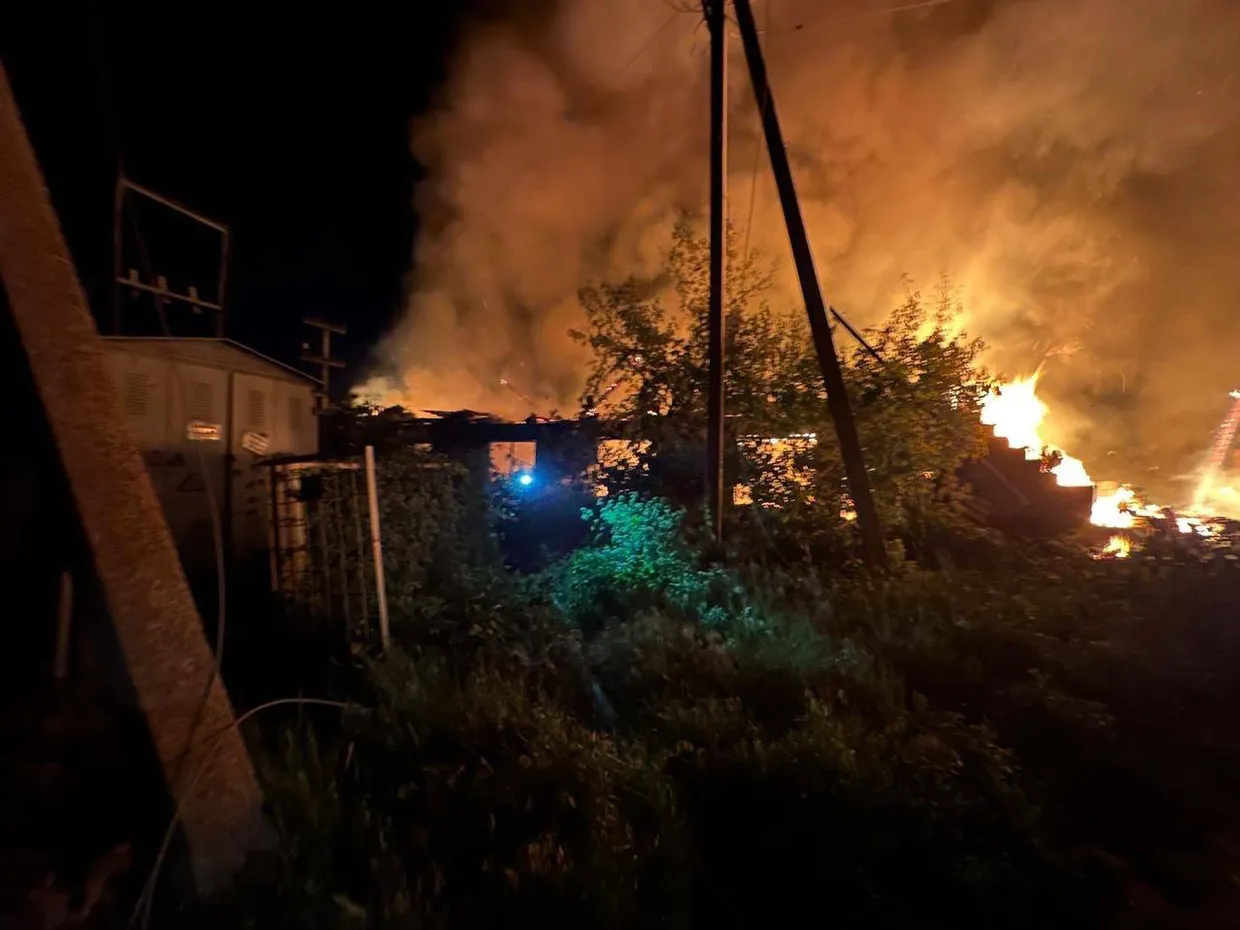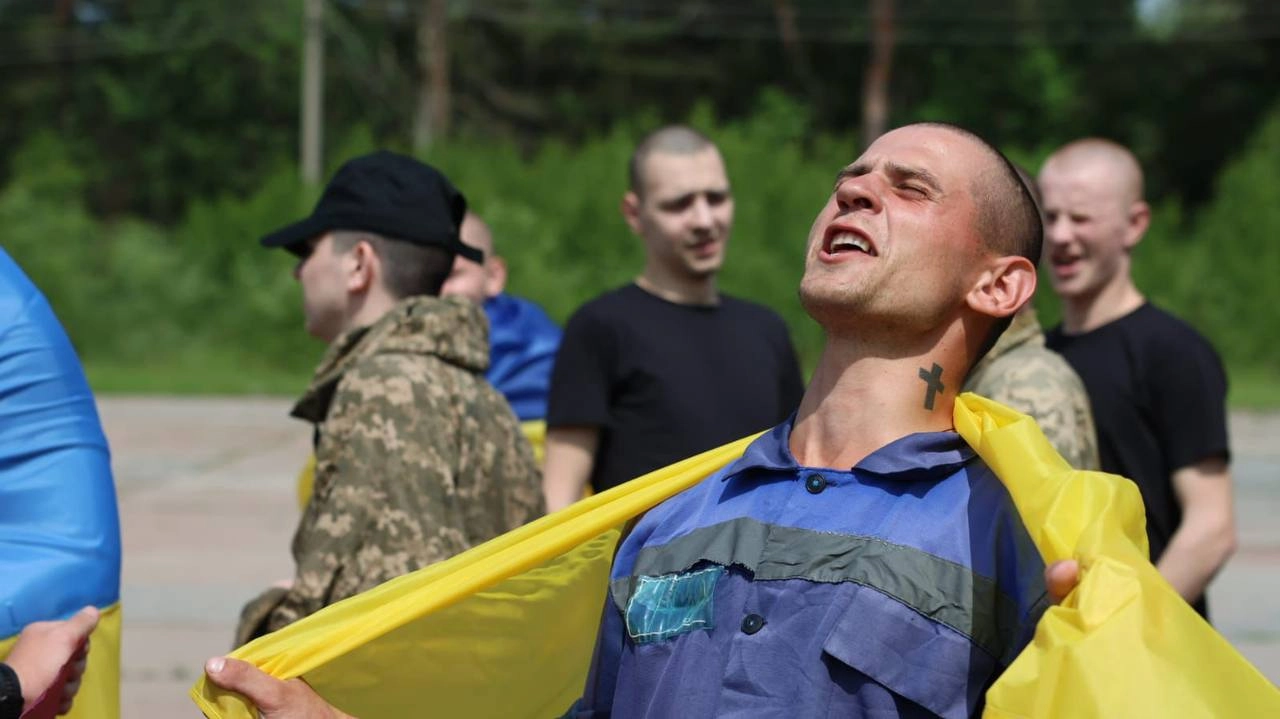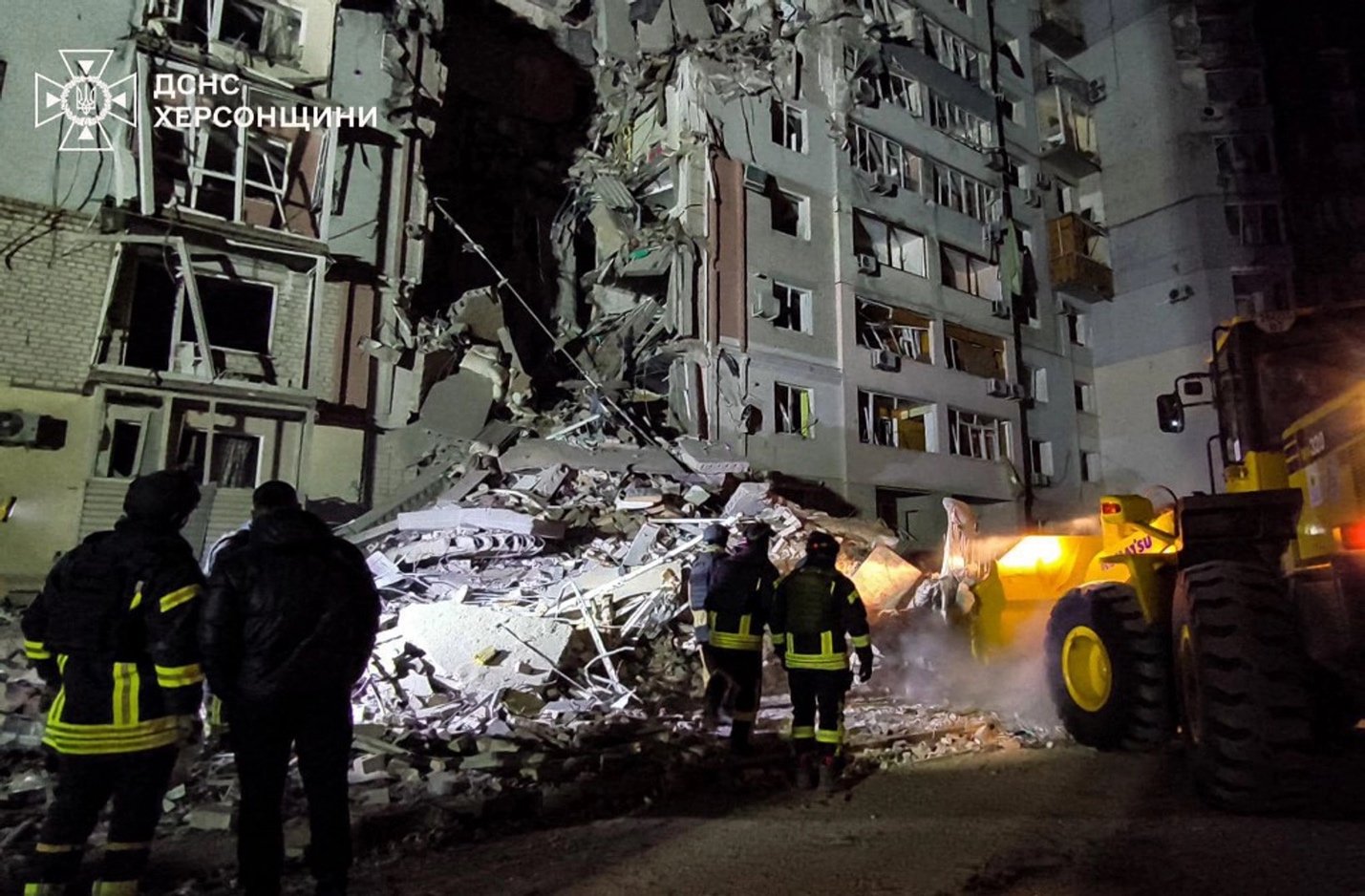As Russia unleashes its largest aerial barrage of the war while advancing toward Dnipropetrovsk Oblast, Ukraine answers with its own deadly precision across enemy territory
Summary of the Day – June 9, 2025
The ninth day of June bore witness to extremes that captured the war’s evolving brutality and Ukraine’s growing reach. Russia launched its largest combined missile and drone assault of the entire conflict—499 projectiles screaming through Ukrainian skies—while its ground forces crossed into Dnipropetrovsk Oblast for the first time, marking a geographic expansion of Moscow’s territorial ambitions. Yet Ukraine demonstrated its own capacity for devastation, striking deep into Russia with surgical precision that damaged strategic bombers and defense installations. Amid this escalation, the war’s human dimension remained paramount as the first major prisoner exchange in months began, reuniting Ukrainian defenders with their homeland after years in Russian captivity. Meanwhile, international responses ranged from Canada’s accelerated defense spending commitments to U.S. prosecutors targeting Russian money laundering networks, while partisan resistance continued behind enemy lines. The day’s events underscored a conflict entering a new phase of intensity, where technological innovation meets territorial hunger, and diplomatic agreements struggle to keep pace with battlefield realities.
The Deluge from Above: Russia’s Record-Breaking Aerial Assault
The predawn hours of June 9 transformed Ukraine’s skies into a hellscape of incoming death. Russian forces unleashed 499 projectiles in what Ukrainian Air Force officials described as the largest combined missile and drone strike of the entire war—a sobering milestone in a conflict already marked by unprecedented aerial terrorism.
The armada included 479 Shahed-type attack drones and decoys launched from Kursk and Oryol cities, Millerovo in Rostov Oblast, Shatalovo in Smolensk Oblast, and Primorsko-Akhtarsk in Krasnodar Krai. The aerial assault was supplemented by four Kh-47M2 “Kinzhal” hypersonic missiles from Tambov Oblast, 10 Kh-101 cruise missiles from Saratov Oblast, three Kh-22 missiles and two Kh-31P anti-radar missiles from Black Sea airspace, and one Kh-35 anti-ship cruise missile from occupied Crimea.
Ukrainian forces managed to intercept 479 of the incoming weapons—277 Shahed and decoy drones shot down, 183 drones suppressed by electronic warfare systems, all 10 Kh-101 cruise missiles, all four Kinzhal missiles, two Kh-22 cruise missiles, both anti-radar missiles, and the single Kh-35 cruise missile. Yet strikes hit Kharkiv, Dnipropetrovsk, Poltava, Kyiv, Rivne, and Volyn oblasts, with Rivne suffering what Governor Oleksandr Koval called “the largest attack since the beginning of Russia’s full-scale war.”

“Of course, there are also hits,” acknowledged Air Force Spokesperson Colonel Yurii Ihnat. “With the number of missiles and drones that Russia is launching, it is impossible to shoot down everything.” The primary target appeared to be one of Ukraine’s airfields, though officials declined to specify which installation bore the brunt of Moscow’s fury.
Crossing the Line: Russian Forces Enter Dnipropetrovsk Oblast
For the first time since 2014, confirmed Russian ground forces crossed into Dnipropetrovsk Oblast, marking a geographic expansion that Kremlin officials quickly framed within their broader territorial ambitions. Geolocated footage showed Russian advances to the administrative border northwest of Horikhove, southeast of Novopavlivka, while elements of Russia’s 90th Tank Division engaged Ukrainian forces in the contested border region.
The rhetoric escalated quickly throughout the day. Kremlin Spokesperson Dmitry Peskov declared the incursion part of Russia’s effort to create a “buffer zone” on Ukrainian territory. First Deputy Chairperson of the Russian State Duma Defense Committee Alexei Zhuravlev claimed Dnipropetrovsk Oblast is now within the “sphere of interests” of the Russian military. Federation Council Committee Chairperson Andrei Klishas claimed the offensive indicates the beginning of Russia’s “denazification” of the oblast. Defense Committee Chairperson Dmitry Sablin declared that Russia will “definitely take” Dnipro City and other Ukrainian cities if Ukraine “does not make peace on [Russia’s] terms.”
Ukrainian officials pushed back with characteristic defiance. “As of the morning of June 9, all Russian information, including Peskov’s statements, about an offensive in Dnipropetrovsk Oblast does not correspond to reality,” countered Andrii Kovalenko, head of Ukraine’s Center for Countering Disinformation. Viktor Trehubov, spokesperson for Ukraine’s Khortytsia group of forces, told CNN that Russian forces had not advanced from the Pokrovsk or Novopavlivka directions.
Yet the geographic reality remained stark: Russian forces had achieved their first confirmed presence in an oblast that had remained free from ground incursions throughout the war’s bloodiest phases.
Ukraine Strikes Back: The Trojan Horse Reinvented
While Russia demonstrated its capacity for mass destruction, Ukraine showcased precision strikes that drew praise from NATO’s highest levels. Ukrainian Special Operations Forces struck the Savasleyka airfield in Nizhny Novgorod Oblast, damaging two Russian military aircraft—a MiG-31 and either a Su-30 or Su-34 fighter jet. The target serves as a launch platform for MiG-31K jets carrying Kinzhal hypersonic missiles.
Simultaneously, Ukrainian Unmanned Systems Forces penetrated deep into Russian territory to strike the VNIIR-Progress enterprise in Cheboksary, Chuvashia Republic, causing a large-scale fire. The facility manufactures critical components for Russian precision-guided weapons, including navigation equipment for glide bombs, control units for Iskander missiles, and satellite navigation modules used in Shahed drones and various cruise missiles.
NATO’s Supreme Allied Commander Transformation, Admiral Pierre Vandier, compared Ukraine’s recent “Operation Spider Web” to the legendary Trojan Horse. The June 1 operation involved hiding drones in trucks deep inside Russia before unleashing them against airfields, causing approximately $7 billion in damage and disabling one-third of Russia’s cruise missile bombers.
“What the Ukrainians did in Russia was a Trojan Horse—and the Trojan Horse was thousands of years ago,” Vandier observed. “Today, we see this kind of tactic being reinvented by technical and industrial creativity.” He emphasized that while drones are indispensable in modern warfare, noting that over 70% of battlefield casualties in Ukraine are caused by drones, they complement rather than replace traditional military equipment.
The Homecoming: Ukraine’s Prisoner Exchange Begins
Against this backdrop of escalating violence, a rare moment of humanity emerged as Ukraine and Russia began their largest prisoner exchange of the war. The first phase returned Ukrainian defenders to their homeland after years in Russian captivity, including Marines who had fought at Mariupol’s Azovstal steel plant.

“Ukrainians are coming home from Russian captivity,” President Volodymyr Zelensky announced. “Today the exchange began and will continue in several stages over the coming days. Among those being returned now are wounded and severely wounded prisoners, as well as those under 25.”
The first group included personnel from Ukraine’s Navy, Ground Forces, Air Force, National Guard, Border Guard Service, Territorial Defense, and State Special Transport Service. Among those freed were defenders of Mariupol who had spent more than three years in captivity—all enlisted and noncommissioned soldiers captured primarily in the first days of Russia’s full-scale invasion.
Human Rights Ombudsman Dmytro Lubinets captured the profound significance: “We warmly welcome all who can now breathe the air of their homeland after years of captivity. Our team shares in the joy of the families who received that precious and long-awaited call.” The exchange covered specific categories—soldiers under 25, the severely wounded, and seriously ill prisoners—representing fruits of direct negotiations held in Istanbul on June 2.
However, Russian officials continued baselessly accusing Ukraine of failing to repatriate bodies of killed soldiers, while the exchange came after Kyiv denied Russian claims of delaying the planned June 7-8 swap. “Unfortunately, the Ukrainian side is once again facing [Russian] attempts to retroactively revise agreements,” Ukraine’s Defense Ministry stated.
The Industrial War: Production, Money, and Strategic Partnerships
NATO Secretary General Mark Rutte delivered sobering assessments revealing that Russia produces as much ammunition in three months as NATO manufactures in an entire year. Intelligence indicates Russia will produce 1,500 tanks, 3,000 armored vehicles, and 200 Iskander missiles in 2025 alone—production occurring alongside ongoing war operations.
“The capabilities of Putin’s war machine are speeding up, not slowing down,” Rutte warned. “Russia is reconstituting its forces with Chinese technology and producing more weapons faster than we thought.” He noted that Russia could be ready to launch military operations against NATO within five years, prompting NATO defense ministers to agree on increasing air and missile defense spending by 400 percent.
The China-Russia nexus has emerged as one of the war’s most consequential developments. Beijing provides an estimated 60 percent of all foreign components found in Russian weapons on Ukrainian battlefields, with Chinese companies supplying 76 percent of Russia’s “battlefield goods” in 2023. Ninety percent of Russia’s microelectronics came from China, while nearly 70 percent of machine tool imports originated from Chinese sources.
This partnership extends beyond trade into comprehensive strategic cooperation spanning military exercises, satellite technology, and geospatial intelligence sharing. The two countries have conducted at least 31 bilateral military exercises since February 2022, while China provides Russia with satellite imagery for military purposes and navigation system integration between Chinese BeiDou and Russian GLONASS systems.
Meanwhile, U.S. prosecutors targeted the financial networks enabling this cooperation, charging cryptocurrency entrepreneur Iurii Gugnin with laundering over $500 million for sanctioned Russian entities. The 38-year-old Russian national used his companies Evita Investments and Evita Pay to convert cryptocurrency from Russian clients into U.S. dollars while concealing transaction origins. Between June 2023 and January 2025, Gugnin facilitated approximately $530 million through the U.S. financial system, helping Russian end-users acquire export-controlled technology and supporting purchases for Rosatom, Russia’s state nuclear company.
Putin’s Naval Ambitions and Nuclear Rhetoric
Russian President Vladimir Putin approved a new naval strategy aimed at fully restoring Russia’s position as a leading global maritime power through 2050. “Russia’s position as one of the world’s greatest maritime powers is gradually recovering,” said Kremlin aide Nikolai Patrushev, though he provided no specific details about the strategy’s contents.
Russia currently operates the world’s third most powerful navy, though the fleet has suffered significant losses during the Ukraine war, particularly in the Black Sea. Ukraine has used naval kamikaze drones to target the Russian Black Sea Fleet since September 2022, reportedly disabling or destroying around one-third of Russian vessels. In response, Russia has begun pulling ships from occupied Crimea to Novorossiysk to shield them from further attacks.
Simultaneously, Moscow continued its pattern of dangling arms control agreements as leverage for Ukrainian concessions. Kremlin Spokesperson Dmitry Peskov claimed Russia retains “freedom of action” regarding intermediate-range missile deployments, while Deputy Foreign Minister Sergei Ryabkov said Russia’s moratorium on such deployments approaches its “logical conclusion.” Officials framed future arms control discussions as contingent upon American respect for Russia’s “fundamental interests”—euphemism for accepting Russian territorial gains in Ukraine.
Allied Responses: From Canada to Montenegro
International responses demonstrated growing recognition that the war’s outcome will determine European security architecture. Canadian Prime Minister Mark Carney announced that Canada will reach NATO’s 2% GDP defense spending target this year—five years ahead of schedule—including a $6.8 billion defense budget boost for 2025-26. Carney acknowledged Canada’s military inadequacies, noting that only one of four submarines is operational, and announced a strategic pivot away from U.S. reliance toward deeper European cooperation.
In an unexpected development, Montenegro announced plans to produce unmanned aerial vehicles in partnership with the United States, with first batches designated as military aid for Ukraine. The $15 million project represents remarkable commitment from a nation of just over 600,000 people that has already allocated €11.3 million in military aid to Kyiv and accepted more than 60,000 Ukrainian refugees.
Even Hungary’s Viktor Orban, widely regarded as the EU’s most pro-Russian leader, made surprising comments questioning Russia’s military capabilities. “The Russians are too weak for that,” Orban told French television. “They’re not even capable of defeating Ukraine, so they’re incapable of really attacking NATO.” However, he maintained opposition to Ukraine’s NATO membership and called for “strategic agreement with Russia.”
Expanding Battlefield Geography: Multiple Fronts Under Pressure
Military operations extended across multiple fronts, illustrating the war’s geographic scope and operational complexity. Ukrainian forces achieved tactical advances near Lyman, with geolocated footage showing progress northeast of Karpivka and east of Torske. Meanwhile, Russian forces pressed forward near Chasiv Yar, with confirmed advances in an industrial area northeast of Stupochky, and in the Toretsk direction with movement northwest of the city.
The Pokrovsk direction remained the war’s most intense sector, with Russian forces concentrating massive resources attempting to encircle Ukrainian positions. Major Viktor Trehubov confirmed that the T-0504 Pokrovsk-Kostyantynivka highway represents the frontline’s most intense sector. In the Kurakhove direction, geolocated footage showed Russian 114th Motorized Rifle Brigade elements raising flags over central Oleksiivka.
Elements of various Russian units participated in operations across fronts: the 90th Tank Division operated in the Novopavlivka direction, the 1442nd Motorized Rifle Regiment advanced near Chasiv Yar, the 4th Motorized Rifle Brigade operated north of Toretsk, and the 656th Motorized Rifle Regiment engaged near Kurakhove.
Simultaneously, Ukrainian and Russian forces conducted operations in Kursk Oblast without significant advances. Ukrainian forces reportedly struck a Russian duty station near Rylsk using HIMARS rockets, while Russian forces attempted entry operations near Tetkino and Novyi Put.
The Human Cost: Systematic Terror and Resistance
Beneath strategic calculations lies the war’s most fundamental reality: devastating civilian impact. New reports from Human Rights Watch and the UN Commission of Inquiry documented Russia’s systematic drone attacks against civilians in Kherson Oblast since summer 2024. Russian forces have intensified their “human safari” campaign using drones to deliberately target civilians, resulting in at least 150 deaths and hundreds of injuries.

The tactics follow deliberate patterns: operators use live video feeds to identify and track civilians, “double tap” strikes target first responders, and attack footage circulates on pro-Russian Telegram channels with mocking commentary. From August through December 2024, drones scattered small plastic anti-personnel landmines in residential areas.
Russian occupation authorities continued consolidating control through digital surveillance and cultural suppression. The Tavria TV and Radio Company launched the first mobile application associated with Russian media in occupied Ukraine, while mobile phone operators in occupied Luhansk Oblast threatened disconnection for individuals failing “verification” with Russian passports.
In occupied Kherson Oblast, schools will introduce curricula designed to encourage high birth rates among Ukrainian youth and propagate traditional Russian family values. Russian occupation courts continued weaponizing “high treason” charges, sentencing individuals to decades in prison for alleged support of Ukrainian forces, including a woman who received 17 years for purchasing a pro-Ukrainian digital postage stamp.
Behind enemy lines, the Atesh partisan group claimed to have destroyed a Russian military vehicle containing electronic warfare systems in occupied Melitopol using incendiary mixtures, demonstrating persistent resistance despite occupation pressures.
A Russian court sentenced two Ukrainian Azov Brigade soldiers to more than 20 years in prison for allegedly killing civilians in Mariupol during April 2022—part of Russia’s ongoing sham trials targeting Ukrainian prisoners of war. Sniper Ruslan Orlov received 26 years while paramedic Artem Novikov got 24 years, reflecting Moscow’s continued demonization of Azov fighters captured during Mariupol’s siege.
Early Strikes Continue the Pattern
As June 9 concluded, early reports indicated continued Russian aerial attacks into June 10. Drone attacks targeted Russia’s Tatarstan Republic and Leningrad Oblast, with footage showing air defenses attempting to intercept drones over locations as far as 1,124 kilometers from Ukraine’s border. Restrictions were imposed at several Russian airports including St. Petersburg’s Pulkovo.

Meanwhile, Kyiv and Odesa came under mass Russian attack involving ballistic missiles and drones. Initial reports indicated casualties in both cities, with attacks damaging medical facilities including a maternity hospital in Odesa, demonstrating the cyclical nature of the conflict’s aerial terrorism.
Looking Forward: The War’s Accelerating Trajectory
June 9 illuminated the war’s continuing evolution from conventional territorial conflict toward something more complex and dangerous. Russia’s territorial expansion into Dnipropetrovsk Oblast represents fundamental challenge to the post-Cold War European order, while Moscow’s record aerial assault demonstrates escalating willingness to target civilian infrastructure supported by Chinese technology and components.
Yet Ukraine’s capacity for strategic strikes deep into Russian territory shows that Moscow’s escalation carries reciprocal risks. The war has become a test of industrial capacity, technological innovation, and societal resilience—metrics on which Ukraine has consistently exceeded expectations despite facing a numerically superior adversary supported by the world’s second-largest economy.
The prisoner exchange provided hope that humanitarian considerations can influence the conflict’s conduct, yet simultaneous escalation suggests such diplomatic progress remains fragile. International responses from increased defense spending to financial sanctions demonstrate growing recognition that this war’s outcome will determine European security architecture for decades.
What remains certain is that both sides have demonstrated capabilities and resolve ensuring the conflict’s continuation. The war that began as Russia’s attempt at quick conquest has evolved into a grinding test of national endurance—one whose outcome will reshape not only European security but global power relationships for generations to come.
